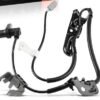Toyota Camry (2007-2014) ABS Speed Sensor
Call for price
- Genuine Toyota Part: Ensures exact fitment and functionality
- Accurate Speed Detection: Provides precise vehicle speed data to the ABS system
- Reliable Performance: Built to withstand harsh road conditions and extreme temperatures
Understanding the ABS Speed Sensor
The ABS (Anti-lock Braking System) speed sensor is a crucial component in modern vehicle safety systems, particularly for models like the Toyota Camry (2007-2014). Its primary function is to measure the rotational speed of the wheels and transmit this critical data to the vehicle’s ABS control module. By doing so, the ABS speed sensor plays an essential role in preventing wheel lock-up during intense braking scenarios. This mechanism ensures that the driver can maintain steering control, thereby enhancing overall vehicle stability during emergency braking situations.
The working principle of ABS speed sensors involves detecting wheel rotation and providing real-time feedback. There are two primary types of ABS speed sensors used in vehicles such as the Toyota Camry: magnetic sensors and Hall-effect sensors. Magnetic sensors rely on the interaction between a magnet and a toothed wheel, where the sensor generates an alternating current (AC) signal proportional to the wheel speed. Meanwhile, Hall-effect sensors use a transducer to vary its output voltage in response to changes in a magnetic field, translating wheel rotation into an electronic signal. Despite achieving the same purpose, the key difference is how these sensors generate and interpret signals.
A malfunctioning ABS speed sensor can significantly compromise braking efficiency and safety. Common indicators of a failing sensor include the illumination of the ABS warning light on the dashboard. This warns the driver that the ABS system is not fully functional. Additionally, an increased stopping distance or inconsistent braking performance may occur, making it harder to control the vehicle during sudden stops. In such cases, it is imperative to diagnose and replace the faulty ABS speed sensor to restore optimal braking performance and ensure vehicle safety.
Understanding the fundamental role of ABS speed sensors illuminates their importance in maintaining safe driving conditions. By continuously monitoring and transmitting wheel speed data, these sensors enable precise braking control, safeguarding both drivers and passengers from potential hazards on the road.
Replacing the ABS Speed Sensor in a Toyota Camry (2007-2014)
When dealing with a faulty ABS speed sensor in a Toyota Camry (2007-2014), it is crucial to follow a structured approach to ensure the repair is correctly executed. The first step involves gathering the necessary tools for the task, such as basic hand tools, a jack, jack stands, and an OBD-II scanner for diagnosis.
Begin by diagnosing the issue using the OBD-II scanner to retrieve any ABS fault codes. These codes will help confirm whether the ABS speed sensor is indeed the culprit. After obtaining the fault codes, prepare your workspace for the sensor replacement process.
Safely lifting the vehicle is essential. Utilize a hydraulic jack to elevate the car and employ jack stands for added stability and safety. Once the vehicle is securely lifted, locate the ABS speed sensor. This sensor is typically situated near the wheel hub assembly.
To access the ABS speed sensor, you may need to remove parts that obstruct it, such as brake components or inner fender liners. Carefully take note of the parts you remove, ensuring they are correctly reassembled later. Once you have a clear view of the sensor, proceed to unplug the old sensor from its connector. This may require disengaging any retaining clips or bolts securing the sensor in place.
With the old sensor removed, install the new ABS speed sensor, ensuring it is properly seated and securely connected. Reattach any components previously removed, making sure everything is restored to its original configuration.
After completing the installation, it is crucial to test the ABS system to confirm the new sensor is functioning properly. Start the vehicle and observe if the ABS warning light remains off. Additionally, use the OBD-II scanner to verify that no fault codes are present.
Troubleshooting common issues that may arise during replacement includes ensuring all connections are clean and tight, and that no foreign particles obstruct the sensor’s alignment. Should issues persist, a re-evaluation of each step can help identify and rectify any missed steps or errors.








Reviews
There are no reviews yet.